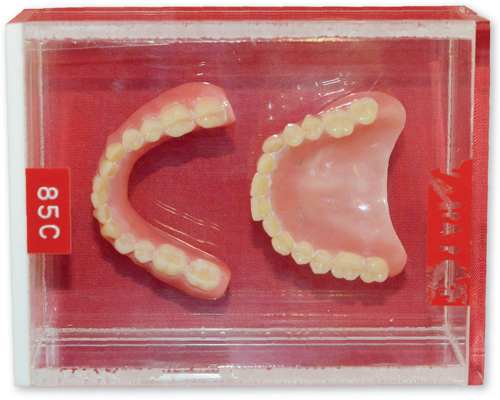

1949
Replica of Olive Durand-Deacon’s false teeth
IN 1949, JOHN Haigh lived at the Onslow Court Hotel in South Kensington where a 69-year-old widow, Mrs Olive Durand-Deacon, was also a resident. Haigh was in debt through gambling losses, but gave the impression of being knowledgeable about business. He invited Mrs Durand-Deacon down to Crawley on 18 February to take forward her idea of making a new type of artificial fingernail for women. Haigh had a connection with a disused motor garage in the area. There he shot her, put her body into a large 40gal drum of acid and then went about the process of selling her watch, coat and jewellery. He took her fur coat to be cleaned prior to selling it.
On return to the hotel in London, Haigh expressed surprise at Durand-Deacon’s disappearance, stating that she had asked him to pick her up outside the Army & Navy stores for their proposed trip to see his factory in Crawley, but that she had not appeared and he had therefore made the trip on his own. In due course, Haigh accompanied another resident to Chelsea police station to report Mrs Durand-Deacon missing; they were dealt with by the astute Sergeant Alexandra Lambourne, who formed suspicions about Haigh and discovered that he had been in prison three times for fraud.
When Detective Superintendent Barratt and Detective Inspector Symes later interviewed Haigh, they had already discovered much about his movements around the Crawley and Horsham area, and presented Haigh with the cleaning ticket for Durand-Deacon’s fur coat. During a short absence from the interview room of the other two detectives, Haigh asked Detective Inspector Webb about the chances of being released from Broadmoor, said that there would be no trace of Durand-Deacon because she had been dissolved in acid and challenged them to prove murder without a body. He then went on to give details of murdering others, eventually reaching a total of eight other people, using the same method of disposing the bodies (these cases were never verified by the police). He also claimed to have drunk his victims’ blood, though this could have been part of an attempt to construct a defence of insanity. It appears he was motivated entirely by financial gain.
Examination of the workshop in Crawley with pathologist Keith Simpson revealed some blood spots above the workshop bench and a hatpin at the bottom of a metal drum that had once contained acid. The sludge from the acid was taken to the Metropolitan Police Forensic Science Laboratory and found to contain fat, gall stones, part of a foot, eighteen bone fragments, a lipstick container, part of a handbag and a set of dentures that were later identified by her dentist as belonging to Mrs Durand-Deacon.
A gas mask, apron, and the .38 Webley revolver used by Haigh are also in the Crime Museum, together with replicas of the gall stones.
Haigh was convicted of Mrs Durand-Deacon’s murder and executed at Wandsworth prison on 6 August 1949.